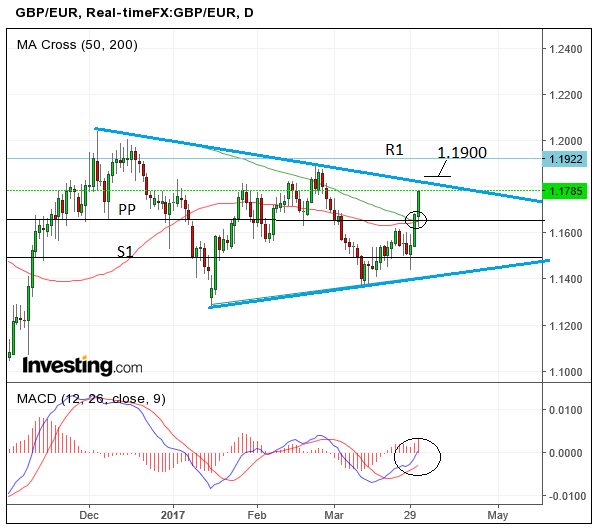British Pound Tipped to Keep Rising Against Euro on Brussels ‘Billet-Doux’

The Pound to Euro Exchange rate (GBP/EUR) starts the new week in the red and is quoted at 1.1755 at the time updating.
Concerning the near-term outlook, our studies suggest the exchange rate might be oscillating and tapering into what may eventually turn out to be a triangle pattern.
The current strong up-move will hit the trendline of the upper border of the triangle at about 1.1815 where it will probably run into tough resistance and stall:
Therefore, we could see recent strength fade at levels just above where we are in the short-term.
But, those wanting a stronger Pound will be hoping that a resolution of any pause will be to the upside in the form of a breakout which could be quite energetic.
We would want to see a clearance well above the triangle’s upper border, confirmed by a break above 1.1835 for this outcome to be put in motion.
If a break-out does occur gains could potentially extend up to 1.1900 and the February highs.
MACD (circled in bottom pane) is poking above the zero-line now, adding further weight to a bullish hypothesis.
The fact the exchange rate has recently broken above the 50 and 200-day MA’s (circled) is also a strong bullish sign, as is the steepness of the current ascent.
The upper border of the nascent triangle pattern, however, will be a key battleground for bulls and bears, with the outcome determining the next directional bias for the pair.
Brussels' ‘Billet-Doux’
While technical studies suggest Sterling might hold the advantage, recall that this remains a politically-charged currency at present.
Therefore, keep an eye on headlines and try not to be surprised by any unexpected moves on unexpected developments in the Brexit story.
Sterling has been strengthening versus the Euro after an unexpectedly conciliatory tone was struck in missives between EU-UK trench lines.
On momentum alone, Sterling should be favoured; since the official triggering of Article 50 on Wednesday, the Pound has gained 2.63% against the Euro resulting in an exchange rate of 1.1785 from 1.1483 previously.
Unexpectedly low inflation figures from the Euro-area helped GBP/EUR higher on Friday after headline CPI fell to 1.5% from 2.0% in March, scuppering hopes of an early end to the European Central Bank (ECB) money-printing programme.
Whilst some analysts now appear to think a ‘hard’ Brexit is unlikely negotiations may take many twists and turns before it is all over, as has already been amply illustrated by Spain’s attempt to veto the status of Gibraltar post-Brexit.
There is still the thorny issue of the UK’s ‘exit bill’ with estimates on both sides ranging from 0-80bn, as well as the scheduling of negotiations, with the UK wanting divorce and new-relationship talks to run concurrently, whilst the EU wants them to occur sequentially, although both sides softened their stances on both these issues in their opening exchanges.
PMI Data is Key
Can Sterling extend its rally against the Euro over coming days? Key to answering the question will be the Purchasing Manager surveys (PMIs) data series for March.
These are important forward-looking gauges of activity in major sectors of the economy.
Manufacturing PMI is out on Monday, April 3 at 9.30 GMT and is expected to remain unchanged at 54.6.
Construction PMI is out on Tuesday at the same time and is forecast to remain at 52.5.
Finally, Services PMI is released on Wednesday at the same time and is expected to rise two basis points to 53.5 from 53.3 previously.
Any beat on expectations will help the Pound higher and disappointment will likely suck some impetus away from the UK unit.
“This week’s PMI surveys for March should provide further evidence that the economy lost some momentum in the first quarter, and that manufacturing output growth probably outpaced services again. Friday’s first official hard data for February should support this view,” said Capital Economics’ Paul Hollingsworth in a note seen by Pound Sterling Live.
Data for the Euro
Eurozone PMI data will be released almost concurrently with UK data except that the Euro-area data will be published a half hour before the UK data on Monday and Wednesday (Construction PMI not noted).
Expectations for Eurozone data are for Manufacturing PMI to come out at 56.2 – the same as before - and Services PMI to come out at 56.5.
Monday will see the significant Eurozone Unemployment rate for March published as well, with forecasts expecting a slight drop to 9.5%.
Retail Sales is the other major data release for the region. It is out on Tuesday, April 4 at 10.00 and s forecast to show a 0.5% rise in March from the previous month’s -0.1%.
February Retail Sales data presented a varied picture across Euro-land, with German Sales rising by 1.8% but French and Spanish data disappointing.
Data is likely to be positive in the week ahead according to Capital Economic’s economist Jessica Hinds.
“This week is likely to bring more good news for the eurozone economy, with retail sales (Tuesday) set to have risen and the unemployment rate (Monday) to have fallen further in February. We also expect national industrial production data for the same month to show monthly rises in Germany, France, and Spain. But we still think that the latest ECB minutes (Thursday) will reveal a strong commitment to its asset purchase plans,” says Hinds.






